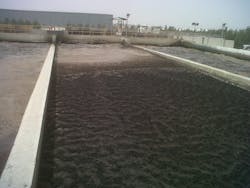The Dubai Investments Park (DIP) wastewater treatment plant (WWTP) is located about 20 miles south of the Burj Khalifa—the world’s tallest building—in Dubai, United Arab Emirates. The oxidation ditch activated sludge plant recently found itself strained by filamentous sludge bulking likely caused by high organic loads, high summer temperatures and inevitable low dissolved oxygen. The problem was solved by replacing ineffective supplemental surface aerators with the Aire-O2 Triton process aerator/mixer engineered by Aeration Industries of Minneapolis.
Evolving Operations
The DIP WWTP is operated by METITO Ltd. under a 30-year build-own-operate-transfer contract. The oxidation ditch is currently treating an average of 2.6 million gal per day (mgd) (10,000 cu meters per day) composed of 70% municipal and 30% industrial waste streams. The wastewater treatment experts of METITO have been successfully treating the influent biochemical oxygen demand of 500 mg/L down to less than 10 mg/L, and influent ammonia levels of 30 mg/L to less than 1 mg/L. Summertime water temperatures are as high as 97°F (36°C).
In October 2010, the total plant capacity was expanded to 8.2 mgd (31,000 cu meters per day) with plans to expand to 21 mgd (80,000 cu meters per day) in the future, thanks to its modular design. The completed project will serve a population of up to 350,000. Features of the system installed at the park include water conservation through reuse of water for irrigation purposes, an environmentally friendly atmosphere and fully automated systems.
A Bulky Challenge
Day-to-day operation of any treatment plant is never short of interesting challenges. Similarly, the DIP WWTP found itself dealing with filamentous bulking and poor sludge settleability evident in the secondary clarifier. Many factors can contribute to this challenge. For example, a temperature of 95°F (35°C) is normally associated with filamentous bulking. Cooling the influent or cooling the mixed liquor can remedy this effect. In this particular case it was determined that more effective supplemental surface aeration would be beneficial for improving mixed liquor suspended solids temperature, floating sludge, low dissolved oxygen and mixing.
Designing a Solution
Water Matrix Technologies FZE of Dubai, manufacturer representative of Aeration Industries, provided a solution by suggesting the use of two, 30-hp (22 kW) Aire-O2 Triton process aerators/mixers to upgrade the existing supplemental high-speed surface aspirator aerators.
Once the Tritons were installed, the results were quickly evident as the powerful mixing and oxygen transfer eliminated the majority of the filamentous bulking. The effects of the Triton are attributed to the proprietary low-RPM, dual-propeller technology coupled with the use of an on-board, high-CFM regenerative blower. The plant also has two existing 177-hp (132 kW) slow-speed, vertically mounted aerators in operation. The use of the Tritons with the existing aerators results in a powerful combination. The vertical aerators provide a high concentration of oxygen in their surrounding areas while the Tritons effectively harness the saturated oxygen cap and channel the aeration plume with downward and horizontal vectors. The result is a high suspension of solids, temperature destratification and greatly increased dissolved oxygen.
Michael Ramirez is director of marketing for Aeration Industries. Ramirez can be reached at [email protected].


